 “I have seen that the earth is composed of layers superimposed on each other at an angle to the horizon.” Nicolas Steno, circa 1671 (all quoted words below are Steno’s)After communing with ghosts during the total eclipse of the sun, and viewing works by artists now long gone at Castle Gardens, I was happily ensconced in the past as I drove east on the Poison Spider Road. Approaching a rock wall rising abruptly from the plains, I thought of Nicolas Steno. He’s been gone for 331 years now, having died at the age of 48 after a decade of futile ministrations and asceticism in the service of the Catholic Church. But his scientific legacy lives on, in the form of basic principles of geology—for example, the Principle of Original Horizontality.As luck would have it, the Poison Spider Road passed through the rock wall on a parcel of State land. I stopped for a closer look, and saw that the wall was composed of layers, and the layers were not horizontal. Because they stood at an angle to the horizon, I knew something had happened. Sometime in the past, this part of the Earth had changed.
“I have seen that the earth is composed of layers superimposed on each other at an angle to the horizon.” Nicolas Steno, circa 1671 (all quoted words below are Steno’s)After communing with ghosts during the total eclipse of the sun, and viewing works by artists now long gone at Castle Gardens, I was happily ensconced in the past as I drove east on the Poison Spider Road. Approaching a rock wall rising abruptly from the plains, I thought of Nicolas Steno. He’s been gone for 331 years now, having died at the age of 48 after a decade of futile ministrations and asceticism in the service of the Catholic Church. But his scientific legacy lives on, in the form of basic principles of geology—for example, the Principle of Original Horizontality.As luck would have it, the Poison Spider Road passed through the rock wall on a parcel of State land. I stopped for a closer look, and saw that the wall was composed of layers, and the layers were not horizontal. Because they stood at an angle to the horizon, I knew something had happened. Sometime in the past, this part of the Earth had changed.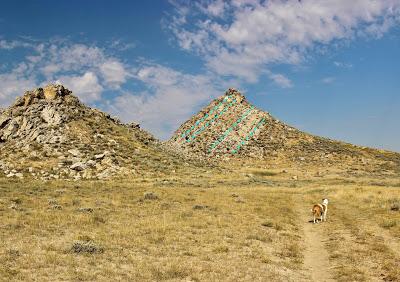
Tilted stack of rocks (layers delineated with blue lines). Dip is to left (southwest), with youngest rocks on left.
The rocks themselves revealed only a little of their history. Clearly they had been deformed; the strata were far from horizontal. Given the location and context, I concluded they most likely were tilted during the Laramide Orogeny—the major mountain-building episode that created the Rocky Mountains approximately 70-40 million years ago. That’s when the majority of Wyoming’s ranges and basins came to be.Later my suspicions were confirmed. The wall—more appropriately a hogback—is part of the west flank of a small anticline (upwarp) associated with the Casper Arch, a Laramide-age uplift separating the Powder and Wind River Basins. The Poison Spider area is complex, with lots of folds and faults. Geologists are still trying to figure out the details, mainly during oil-and-gas exploration.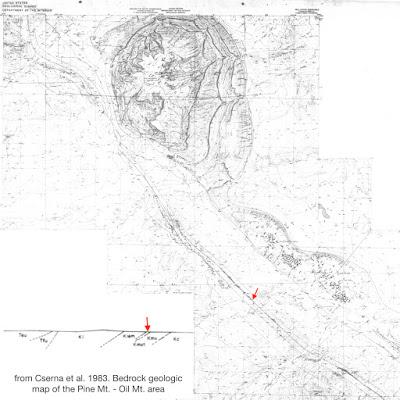
Poison Spider area west of Casper, Wyoming (Cserna et al. 1983). Arrows mark the long narrow exposure of Teapot Sandstone, and its position in cross-section (click on image to view details).
This striking hogback is made of Teapot Sandstone, a member of the late Cretaceous Mesa Verde Formation. It’s hard and resistant to erosion, which explains why it stands alone on the high desert. Softer adjacent strata have been worn down.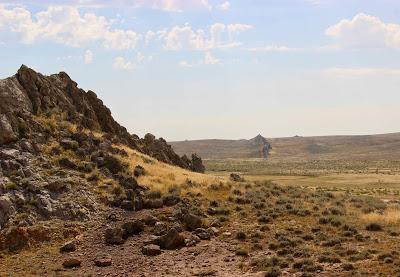
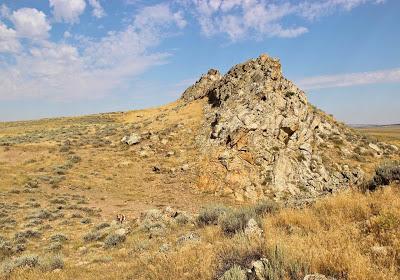
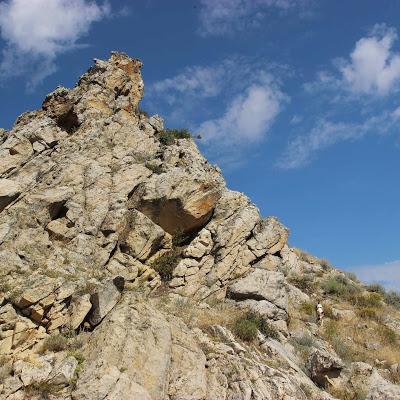
Thanks to geological knowledge accumulated over centuries, I can indulge in informed speculation when I find something of interest. Not so Nicolas Steno. In his day, geology was still in earliest infancy; he had only his observations and amazing mind to guide him.Steno had observed sediments settling slowly in water, and forming horizontal layered deposits on the bottom of a container. This also would happen in shallow seas, lakes, and such. Furthermore, the rocks that later formed from the sediments—sedimentary rocks—would be horizontal too … unless something had happened. Thus tilted, folded, or fractured sedimentary rocks indicated that the Earth was not always as it is today. The landscape can change radically given enough time.
“… strata either perpendicular to the horizon or inclined to it, were at one time parallel to the horizon.”
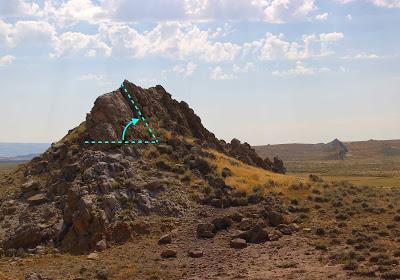
Original Horizontality is the second of Steno’s great principles. The first is the Principal of Superposition: “When the lowest stratum was being formed, none of the upper strata existed.” In a stack of sedimentary rocks, the oldest will be at the bottom, the youngest on top; thus the stack is a record of Earth history. Steno's second principal begat today’s stratigraphy.
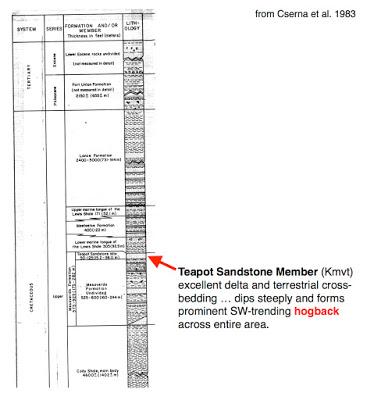
Partial stratigraphic column (rock stack) for the Poison Spider area tells of advancing and retreating seas.
Steno’s third principle is Lateral Continuity. Sediments are laid down in continuous sheets unless something stands in the way, like an island. The resulting rocks are laterally continuous as well. He developed these principles in the process of deducing and proving that “figured stones” (today’s fossils) began as living organisms. But these principles also revealed what might be Steno's grandest conclusion—that the Earth changes profoundly over time. It's quite possible for sea floors to become mountain tops, replete with shells.But why does the Earth change? How do mountains rise? Today we know of plate tectonics, through which huge fragments of the Earth’s crust move, jostle, bump, pull, sink, compress and stretch … creating mountain ranges, basins, islands, volcanoes, oceans, and more. But for Steno, back in the 17th century, the Old Testament of the Bible was the only source of explanation, and sometimes it conflicted with his discoveries. Throughout his geological studies, Steno remained religious, as did most scientists of the time; science was considered a way to understand God’s work. But his findings drove him to conclude that the Bible was not to be taken literally, that it was an imperfect work of Man.Even as he continued studying fossils and Earth history, Steno’s attentions turned increasingly to religion. He had earlier converted to Catholicism, and in 1677, was appointed a titular bishop and sent to Germany to convert Lutherans back to the faith (Counter-Reformation). It was a difficult frustrating mission. Six years later Steno resigned, and spent the last five years of his life as an ascetic, living “devoid of all life’s comforts, lean pale and emaciated” as described by a friend.From his surviving writings, some have concluded that the great uncertainty that surrounded the cause of change to the Earth led Steno to seek solace in religion and asceticism (see Cutler, chapter 13). But if uncertainty were such a demon, why did Steno speak these now famous words, in his final public talk in 1673?“Beautiful is what we see. More beautiful is what we understand. Most beautiful is what we do not comprehend.”
I wish that Nicolas Steno’s soul resided in a place where he could watch the centuries unfold. He would see his principles widely accepted, even institutionalized. Stephen Jay Gould would anoint him Founder of Geology, and in 1988, after a 50-year campaign, he would be beatified by Pope John Paul II, who noted his contributions to science (Steno’s feast day is 5 December). And he would be able to rest in peace, comforted by the principles of plate tectonics, which explain how the Earth changes profoundly over time.

Bishop Nicolas Steno; source.
The following books include much more about the amazing life of Nicolas Steno:Cutler, Alan. 2003. The Seashell on the Mountaintop—a biography of Steno emphasizing his pioneering contributions to geology and paleontology.Alvarez, Walter. 2009. The Mountains of Saint Francis; discovering the geologic events that shaped our earth. Steno figures prominently in this wide-ranging entertaining account of the history of geology.Other sources:Steno's Laws or Principles, by Andrew Alden. March 09, 2017 https://www.thoughtco.com/stenos-laws-or-principles-1440787Deciphering the Layers of Earth, by David Bressan. January 12, 2012 https://blogs.scientificamerican.com/history-of-geology/deciphering-the-layers-of-earth/Cserna, EG., Kerns, GJ, and Laraway, WH. 1983. Bedrock geologic map of the Pine Mountain-Oil Mountain area, Natrona County, Wyoming. USGS Open-File Report 83-748. https://pubs.er.usgs.gov/publication/ofr83748Steno, N. 1671. The Prodromus to a dissertation concerning solids naturally contained within solids. Laying a foundation for the rendering a rational account both of the frame and the several changes of the masse of the Earth, as also of the various productions in the same. [English translation] http://lhldigital.lindahall.org/cdm/ref/collection/earththeory/id/6605
